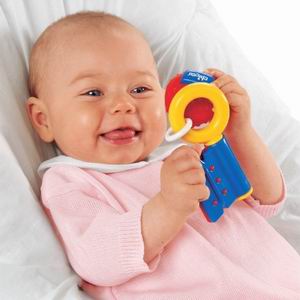Ten Precautions for Choosing and Buying Toys for Babies_Baby Games_Sina Blog
In daily life, when buying toys for babies, choosing ones that are not only liked by the baby but also safe and educational from thousands of options can be a matter requiring attention and effort. The following points of attention can be referred to:
1. Choose toys that help with children's physical and mental development
Based on different ages, choose toys that can enhance the child’s physical and mental development, such as promoting social skills, communication skills, motor skills, hand-eye coordination, building confidence, cultivating imagination and creativity.
2. Choose toys that allow children to participate
Are you letting the child participate? If a toy is just pretty and lets the child quietly admire it without learning new things while playing, then it is not a good toy. Toys should encourage children to explore and imagine, creating fun in the process. "Beautiful but useless" toys will make the child an observer rather than a participant, leading to them easily losing interest in the toy.
3. Choose age-appropriate toys
Buying a remote control plane for a three-year-old might not yield good results. Besides selecting toys suitable for the child's age, you can also select toys meant for slightly older children. Parents can play with these toys, allowing the child to imitate them.
4. Choose toys that can "grow" with the child
Balls are a good choice. From touching and playing with them at a young age, to playing soccer with other children as they grow older; books are also a good choice, suitable for children of all age groups.
5. Choose toys that maintain the baby's long-term interest
Toys in a child's hands usually lose their appeal within a few days, wasting the parents' money! When buying toys, consider whether they are durable against falls, chewing, and washing.
6. Choose safe toys
This is something parents need to pay special attention to when purchasing toys. Small parts in toys, breakable or detachable components, sharp objects, or toys that can easily be bitten by the child, all pose dangers.
7. Try out the toy yourself first
Before buying a toy, try it out yourself to see if it is safe and whether it can benefit the child. You can watch other children try it out in the store before making your decision.
8. Parents should read the instructions for use of children's toys beforehand
For toys that require maintenance, the methods will be clearly stated in the instruction manual. This is especially true for complex toys or infant toys. For infant toys, check if there are cleaning or sterilization methods mentioned, such as whether they can be high-temperature sterilized or washed.
9. Observe the child playing with the toy
Observe the child playing with the toy. If they are highly engaged and not easily distracted by other things, then you have succeeded.
10. Regularly maintain and inspect the child's toys
Toys for children under 3 years old should be regularly checked with particular attention. Check items such as whether screws are loose; whether small parts on plush toys (such as noses, eyes, etc.) are detached; whether plastic toys have cracks that could cause other dangers.
The safety of a baby's toys cannot be ignored, and parents should ensure the quality of the toys they buy for their babies. At the same time, it is most important to choose appropriate types of toys based on the characteristics of each growth stage of the baby, aiming to select the most suitable companions for the baby's growth.
